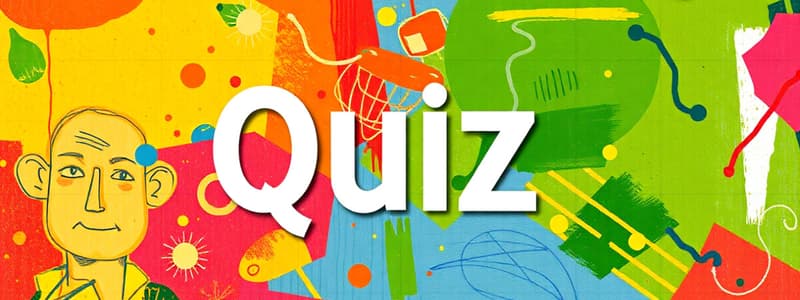Podcast
Questions and Answers
What are the three activities in information systems that produce the information organizations need?
What are the three activities in information systems that produce the information organizations need?
- Input, feedback, output
- Processing, feedback, evaluation
- Input, processing, storage
- Input, processing, output (correct)
Which group is primarily responsible for the creation and design of new products or services?
Which group is primarily responsible for the creation and design of new products or services?
- Knowledge workers (correct)
- Data workers
- Operational workers
- Senior management
What is a primary challenge businesses face related to technology?
What is a primary challenge businesses face related to technology?
- Enhancing employee benefits
- Expanding market reach
- Data protection (correct)
- Maintaining customer satisfaction
Which statement best describes managerial levels in an organization?
Which statement best describes managerial levels in an organization?
What is the focus of management information systems (MIS)?
What is the focus of management information systems (MIS)?
Which of the following is NOT considered an IT innovation affecting management information systems?
Which of the following is NOT considered an IT innovation affecting management information systems?
What is a key characteristic of an emerging digital firm?
What is a key characteristic of an emerging digital firm?
Which strategic business objective focuses on enhancing operational efficiency for greater profitability?
Which strategic business objective focuses on enhancing operational efficiency for greater profitability?
What does the term 'time shifting' refer to in the context of digital firms?
What does the term 'time shifting' refer to in the context of digital firms?
Which of the following innovations enables the development of new business models?
Which of the following innovations enables the development of new business models?
What do key corporate assets managed via digital means include?
What do key corporate assets managed via digital means include?
Which of the following is NOT a component of an information system?
Which of the following is NOT a component of an information system?
Which emerging technology is associated with the Fourth Industrial Revolution?
Which emerging technology is associated with the Fourth Industrial Revolution?
What defines the components involved in input, processing, and output activities in IT?
What defines the components involved in input, processing, and output activities in IT?
What is the purpose of data management technology in an IT infrastructure?
What is the purpose of data management technology in an IT infrastructure?
Which of the following is NOT considered a managerial asset in the context of technology implementation?
Which of the following is NOT considered a managerial asset in the context of technology implementation?
What are complementary assets and why are they important?
What are complementary assets and why are they important?
What is the function of intranets in an organizational context?
What is the function of intranets in an organizational context?
Which of the following best describes the behavioral approach in the study of information systems?
Which of the following best describes the behavioral approach in the study of information systems?
Which asset is crucial for enhancing organizational performance and decision-making processes?
Which asset is crucial for enhancing organizational performance and decision-making processes?
What type of technology connects two or more computers to share data and resources?
What type of technology connects two or more computers to share data and resources?
Flashcards are hidden until you start studying
Study Notes
-
No specific content or information was provided to summarize or create study notes from the text.
-
No specific content or topics were provided for summarization.
-
Study notes cannot be generated without identifiable information or text.
-
Please provide relevant information or questions for effective notes.
Changes in Management Information Systems
- Five major changes include IT innovations, new business models, e-commerce expansion, management changes, and shifts in organizational structures.
- IT Innovations:
- Emergence of cloud computing, mobile digital platforms, big data, IoT, business analytics, machine learning, and social media for business objectives.
- Innovations facilitate new products/services, unique business models, and transformation of daily business operations.
- New Business Models:
- Example: EY provides online video services for streaming and downloading.
- E-commerce Expansion:
- Alterations in design, production, and delivery processes of products.
Organizational Changes
- Emerging Digital Firms:
- Organizations with significant business relationships digitally enabled and mediated (e.g., Coca-Cola's operations through digital networks).
- Business Processes:
- Collection of logically related tasks and actions developed over time.
- Corporate Assets:
- Managed digitally; includes intellectual property, core competencies, and financial/human resources.
- Time and Space Shifting:
- Operations can occur 24/7 globally and nationally.
Strategic Changes
- Changes in strategy, rules, and business processes necessitate modern hardware, software, databases, and telecommunications.
- Business Models:
- Outline how a company creates, delivers, and sells products/services for wealth creation.
- Strategic Business Objectives of Information Systems:
- Key objectives: operational excellence, new product/service development, customer and supplier intimacy, improved decision-making, competitive advantage, and survival.
Information Systems Overview
- Digital Divide:
- Involves access, skill levels, and content in areas like education, entertainment, and e-commerce.
- Information Technology (IT):
- All hardware and software necessary for meeting business objectives.
- Information Systems (IS):
- Interrelated components for collecting, processing, storing, and distributing information to support decisions and control.
Information Processing
- Three key activities in IS:
- Input: Capture and collect raw data.
- Processing: Convert raw data into meaningful formats.
- Output: Transfer processed information to users.
- Feedback Mechanism:
- Output that aids in evaluating or correcting the input stage.
Business Challenges and Management Tasks
- Key challenges include data protection, innovation maintenance, job automation, managing a global workforce, and adapting to political changes.
- Literacies:
- Information Systems Literacy: Understanding of the management, organizational, and technical dimensions of IS.
- Computer Literacy: Knowledge of IT tools.
- Managerial Levels:
- Senior management focuses on long-term strategic decisions, while middle management executes plans, and operational staff monitors daily activities.
Major Business Functions
- Functions encompass Sales & Marketing, Manufacturing & Production, Finance & Accounting, and Human Resources.
- Culture involves shared assumptions, values, and work practices.
IT Components
- Computer Hardware: Physical devices for input, processing, and output.
- Software: Programs and instructions governing hardware operations.
- Data Management Technology: Software managing data on physical storage.
- Networking Technology: Links hardware for data sharing and communication.
- Internet: A global network connecting millions of smaller networks.
- Intranet and Extranets: Private networks based on internet technology for internal and authorized external access.
Organizational and Managerial Assets
- Supportive culture prioritizing efficiency and effectiveness is vital.
- Investment in technology requires strong senior management support, incentives for innovation, and training programs to enhance decision-making skills.
- Complementary Assets: Additional resources necessary for deriving value from primary investments.
Academic Disciplines in IS
- Technical Approach: Focuses on mathematical models and physical technologies in IS study.
- Behavioral Approach: Centers on behavioral issues in the development and long-term management of information systems.
Studying That Suits You
Use AI to generate personalized quizzes and flashcards to suit your learning preferences.




